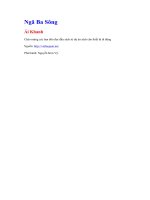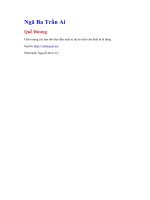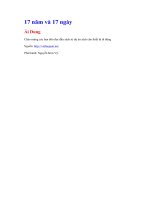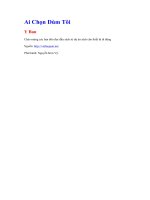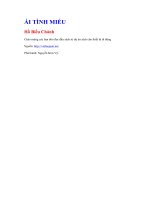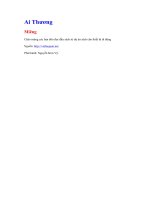AI boehringer ingelheim webinar 220526
Bạn đang xem bản rút gọn của tài liệu. Xem và tải ngay bản đầy đủ của tài liệu tại đây (4.7 MB, 58 trang )
Facts about Highly Pathogenic
Avian Influenza spread and control
Sponsored by:
Upcoming and On-Demand Webinars
June 7, 2022
“Biosecurity tips to mitigate Avian Influenza risks,”
sponsored by Cobb-Vantress
To register for upcoming webinars, view an archive of today’s webinar or see On-Demand
webinars on related topics, please visit: www.wattpoultry.com/webinars
Sponsored by:
Boehringer Ingelheim
Innovative medicines for people and animals for more than 130 years been what the
research-driven pharmaceutical company Boehringer Ingelheim stands for. Creating value
through innovation for human pharmaceuticals, animal health and biopharmaceutical.
Boehringer Ingelheim believes that prevention is better than cure and therefore focuses on
developing innovative solutions in the areas of vaccines. With a rich product line of
advanced preventive health products, tools and services, the company helps its clients
caring for the health of their animals.
For additional information on products and services offered by Boehringer Ingelheim, please
visit www.boehringer-ingelheim.com
Sponsored by:
Today’s Speakers
Dr. David E. Swayne,
DVM, Ph.D., DACVP, DACPV
USDA
Dr. Stephane Lemiere, DVM
Boehringer Ingelheim
Sponsored by:
Dr. David E. Swayne is the Laboratory Director (1994-present) of U.S.
Department of Agriculture’s in house high biocontainment laboratory for
poultry health research. He has a Doctorate of Veterinary Medicine
(University of Missouri, 1984), M.Sc. in Veterinary Pathology (University of
Missouri, 1984), a PhD in Veterinary Pathology (University of Georgia,
1987), and is a board certified in Veterinary Pathology and as a Poultry
Veterinarian. For past 31 years, his personal research has focused on
pathobiology and control of avian influenza in poultry. He has participated in
missions or conferences on avian influenza control and biosafety/biosecurity
in 51 countries during the past 24 years. He has published over 319 peerreviewed papers and 104 book chapters on poultry health issues, principally
avian influenza and other emerging viral diseases, and has given 307
invited presentations on poultry health issues. He is on the editorial board of
Avian Diseases and is an Associate Editor for Influenza and Other
Respiratory Viruses. He has also served as an Associate Editor and Advisor
for Avian Pathology and Associate Editor for Veterinary Pathology.
Sponsored by:
Introduction, History, Epidemiology, and Current
Experience with High Pathogenicity Avian Influenza
David E Swayne
Southeast Poultry Research Laboratory, U.S. National Poultry Research Center,
Agricultural Research Service, U.S. Department of Agriculture, Athens, Georgia,
USA
Thanks for Scientific Contributions from ARS Colleagues:
Erica Spackman, Sungsu Youk, Mary Pantin-Jackwood, Christina
Leyson, Darrell Kapczynski, Dong-Hun Lee, Kateri Bertran, Miria
Criado, Jung-Hoon Kwon, David Suarez, Mia Torchetti, Mary Lea
Killian and others (USDA/APHIS/VS, WS & ICG; USGS; NIH;
NAHLN & State Dept Agriculture)
Disclaimer: This presentation is based on current scientific data and is not an endorsement of any specific product or company
1. Avian Influenza Virus
• Small Virus (Orthomyxovirus) with protein
projections on the surface:
• 16 hemagglutinin subtypes (i.e. H1-H16)
• 9 neuraminidase subtypes (i.e. N1-N9)
• Thus named: H5N1, H9N2, H5N2, etc.
• Vary in disease production (chickens):
• Low pathogenicity (LPAIV): local replication mild respiratory disease and egg drop – virus in
respiratory & digestive organs/tissues, surface of
eggs; e.g. H9N2 LPAIV but can be any H1-16
• High pathogenicity (HPAIV): systemic - deadly
disease (some H5 & H7) – virus in all
organs/tissues & inside and on surface of eggs; e.g.
H5N1 HPAIV
• Can infect a variety of poultry and wild birds,
depending on virus strain
• Migratory aquatic birds are the reservoir of
LPAIV
2. Avian Influenza Virus Ecology/Epidemiology
LPAIV
(H1-16)
Primordial
Reservoir
Exposure
Adaptation
HPAI (H5/H7) control varies with
strain and country needs/resources
• EMERGENT strains –
stamping-out and eradicated
• PERSISTENT strains
– Stamping-out
– Managed control (limited stampingout plus vaccination)
National Wildlife Refuge Association
LPAIV
(H1-13)
• Outdoor rearing
• Outdoor access
• Wild bird access to buildings
• Environmental exposure
H5/7 HA
Mutation
HPAIV
Avian Influenza Virus Ecology/Epidemiology
Domestic
• Our understanding of the role
Waterfowl
for wild aquatic birds in
LPAIV
ecology/epidemiology of LPAI
(H1-16)
LPMs
Primordial
has developed since 1960’s
Reservoir
• A new paradigm
Wild
involving domestic
H5Nx Gs/GD
Exposure
Aquatic
Eurasian lineage
waterfowl, and
Adaptation
HPAIV
Birds
multiple wild aquatic,
predatory and
periurban birds in
H5/7 HA
LPAIV
the ecology &
HPAIV
Mutation
(H1-13)
epidemiology of
Gs/GD Eurasian
lineage of HPAI
Terrestrial Poultry
Terrestrial Poultry
High Pathogenicity Avian Influenza
1. 1959: Scotland, H5N1
2. 1961: S. Africa, H5N3
3. 1963: England, H7N3
4. 1966: Canada, H5N9
5. 1975: Australia, H7N7
6. 1979: Germany, H7N7
7. 1979: England, H7N7
8. 1983-84: USA, H5N2
9. 1983: Ireland, H5N8
10. 1985: Australia, H7N7
11. 1991: England, H5N1
12. 1992: Australia, H7N3
13. 1994: Australia, H7N3
§14. 1994-5: Mexico, H5N2 (LPAIV persists)
§15. 1995 & 2004: Pakistan, H7N3
16. 1997: Australia, H7N4
17. 1997: Italy, H5N2
§18. 1996-present: Asia/Europe/Africa/N.
America, H5Nx (including N1, N2, N3, N5,
N6, N8 reassortants)
19. 1999-2000: Italy, H7N1
20. 2002: Chile, H7N3
21. 2003: Netherlands (BLGM, GRM), H7N7
22. 2004: USA, H5N2
23. 2004: Canada, H7N3
24. 2004: S. Africa, H5N2 (ostriches)
25. 2006: S. Africa, H5N2 (ostriches)
§26. 2005: N. Korea, H7N7
27. 2007: Canada, H7N3
28. 2008: England, H7N7
29. 2009: Spain, H7N7
30. 2011-3: S. Africa, H5N2 (Ostriches)
31. 2012: Chinese Taipei, H5N2
§32. 2012-present: Mexico, H7N3
33. 2012: Australia, H7N7
34. 2013: Italy, H7N7
35. 2013: Australia, H7N2
36. 2015: England, H7N7
37. 2015: Germany, H7N7
38. 2015: France, H5Nx
39. 2016: USA (Indiana), H7N8
40. 2016: Italy, H7N7
41. 2017: China, H7N9
42. 2017: USA (Tennessee), H7N9
43. 2020: USA (S. Carolina), H7N3
44. 2020: Australia (Victoria), H7N7
§Vaccine used in the control strategy
•
•
•
•
H5Nx Gs/GD Eurasian lineage first reported in China in domestic geese during 1996
Largest & longest since 1920-30, >500 million poultry died/culled
Affected more poultry than the other 43 HPAI Disease Events combined
>84 countries in poultry, wild birds or humans (Endemic in 6 & recurring in 10-12
countries)
• Focused on Northern Hemisphere across Asia, Europe, Africa and North America
H5 Gs/GD Eurasian-lineage HPAIV
• Since 1996 – H5 hemagglutinin
gradual changed (DRIFT) to form
divergent genetic clades of H5 HPAIV
• Now at fifth order clade - 2.3.4.4a,
2.3.4.4b, 2.3.4.4c…….2.3.4.4h
• Gene reassortment (Shift) of
neuraminidase. Now – H5N1,
H5N2….H5N9
• Wide geographic dispersion via
migratory aquatic birds – some
asymptomatic and other with high
mortality and severe lesions
• Co-detections in migratory birds and
poultry
Median Time of the Most Recent
Common Ancestor (tMRCA)
2.3.4.4c
2.3.4.4c
November 2012
• 3rd order clade 2.3.4 tMRCA in
2005 (China)
• 4th order clade 2.3.4.4 tMRCA
in June 2007 (China)
• 5th order clades diverged:
2.3.4.4b
• 2.3.4.4a – China, 9/2012 tMRCA
• 2.3.4.4b – Korea, 4/2013 tMRCA
• 2.3.4.4c – China, Korea, Japan,
Europe, N. America; 6/2013
2.3.4.4a
tMRCA
• 2.3.4.4d-f – China, 11/2012
tMRCA
2.3.4.4d
2.3.4.4e
2.3.4.4f
June 2007
2.3.4.4
Emerging Infectious Diseases 22(7):1283-1285, 2016.
DOI: 10.3201/eid2207.160048
HPAI Status
Highly Pathogenic Avian Influenza
• HPAI – internationally
controlled disease with
persistent Gs/GD lineage
majority of cases >>
H7N9 Eurasian lineage
>> H7N3 N. American
lineage >>> Emergent H7
> Emergent H5
• Number of Outbreaks:
2005-2022- 5 main peaks:
•
•
•
•
•
Source: OIE
2.2
2.3.2.1
2.3.4
2.3.4.4c
(2.3.4.4A)
2.3.4.4b
2.3.4.4b
2005: 2.2 clade
2007-2008: 2.3.2.1 clade
2014-2015: 2.3.4.4c clade
2016-2017: 2.3.4.4b clade
2020-2022: 2.3.4.4b clade
Source: OIE
H5 Gs/GD Eurasian-lineage HPAIV
OIE
• Since Fall 2020, 2.3.4.4b has moved from Central Asia to Europe, Eastern Asia, Middle East, Africa and N. America with
evidence of bi-directional movement within fall and spring migrations.
• 5771 cases
• 154.7 million poultry deaths + culled
H5 Gs/GD Eurasian-lineage HPAIV: N. America
1. Eastern Canada (Atlantic Flyway)
• 4 November 2021 – 2 Great Black-backed
Gulls, Avalon Peninsula, Newfoundland
• 9 December 2021 – Exhibition farm 419
bird species (chickens, turkeys, emus,
geese, ducks, guinea fowl and peafowl),
Avalon Peninsula, Newfoundland
• Additional backyard birds, wild birds and
commercial poultry cases
• Wild birds (various species of ducks, gulls,
geese, raptors, crows, songbirds)
• Initially - Newfoundland, Prince Edward
Island, New Brunswick, and Nova Scotia,
but has spread westward
2. Western Canada (Pacific Flyway)
• 3 February 2022 – Bald Eagle in
Vancouver, British Columbia
Source: OIE Reports, />
OIE
H5 Gs/GD Eurasian-lineage HPAIV: N. America
1. Eastern USA (Atlantic Flyway)
• 30 December 2021– American Widgeon
and Blue-winged Teal, Colleton County,
South Carolina. Hunter harvested ducks
2. As of 5/17/22, 1190 infected wild birds
3. Flyways
• Atlantic
• Mississippi
• Central
• Pacific
4. Source:
• Hunter or agency harvested: 42%
• Live bird: 27%
• Wild bird mortality: 31%
USDA/APHIS
National Wildlife Refuge Association
Source: OIE Reports and
/>
H5 Gs/GD Eurasian-lineage HPAIV: N. America
1. Anseriformes
•
•
•
•
•
2.
Raptors (Birds of Prey) - Mortality
•
•
3.
Scolopacidae: Sanderling
Laridae: Herring Gull, Ringed-billed Gull & Gull unidentified
Pelecaniformes – Mortality
•
•
5.
6.
7.
Accipitriformes: Turkey Vulture, Black Vulture, Bald Eagle, Red-shoulder Hawk, Red-tailed Hawk, Coopers Hawk, Peregrine
Falcon, sharp-skinned hawk, Northern Harrier
Strigiformes: Snowy Owl, Great-horned Owl
Charadriiformes - Mortality
•
•
4.
Dabbling Ducks: Blue-winged Teal, Northern Shoveler, American Widgeon, Gadwall, Mallard, Northern Pintail, Green-winged
Teal, Black Duck & Wood Duck: hunter harvested or live bird >>> Mortality
Diving ducks: Lesser Scaup, Redhead Duck, Hooded Merganser & Ruddy Duck - mostly mortality
Geese: Snow Geese, Lesser Snow Geese, Ross Geese & Canada Geese - 0-88% mortality
Swans: Mute Swan, Black Swan, Trumpeter Swan & Tundra Swan – 100% mortality
Loons: Common Loon
Pelecanidae: Brown Pelican & White Pelican
Ardeidae - Great Blue Heron
Suliformes – Double Crested Cormorant
Gruiformes – Sandhill Crane
Passeriformes – American Crow, American Robin, Common Grackle
Source: OIE Reports and
/>
H5 Gs/GD Eurasian-lineage HPAIV: N. America
USA:
• 8 February 2022 – Backyard Flock,
Farquier County, Virginia. 119 birds
(turkeys, chickens, geese and ducks); 40%
mortality
• As of 5/18/2022, 148 outbreaks in
backyard flocks
• 7 February 2022 – Commercial meat
turkeys (29,000), Dubois County Indiana.
Decreased water consumption, lethargy
and increased mortality.
• As of 5/18/2022, 179 outbreaks in
commercial poultry (>37M poultry)
• Stamping-out policy
• No vaccine used
Source: OIE Reports and
/>
2014-15 H5 (2.3.4.4c) vs 2022 (2.3.4.4b)
Midwest: Central/
MS flyways
Pacific Flyway
OIE Non-Poultry
Poultry
60
Comparisons of epidemiological data
# of Premises
50
40
30
35 45
20
20
22
8
10
0
13
25
21
4
3
2
4
4
3
9
2
8
9
9
20
19
8
12
7
10
7
11
Source: APHIS NPIC (Nhu-Phuong Duong)
3
4
• 2022 – 35 states affected; 2014-15 - 21 states
• 2022 – 1190 wild bird cases; 2014-15 with 75
• 2022 – 4 flyways affected; 2014-15 - 3
flyways
• Commercial/Backyard the epi-curve shifted
left on timeline with higher weekly cases peak
vs 2014-15
• Higher proportion of backyard to commercial
in 2022 vs 2014-15 (44% vs 9%)
Viral migration of 2.3.4.4c HPAI
Viral migration of 2.3.4.4b HPAI
Viral migration of 2.3.4.4d-f HPAI
Viral migration of 2.3.4.4a HPAI
Breeding site of migratory wild birds
Virus circulation in poultry
N America
Winter/Spring,
2022
DEC 2014 – JUN 2015
In North America
Fall, 2021
North America
Winter/Spring,
2014-2015
breeding site
Summer, 2021
Spring, 2021
Europe
Winter, 2014-2015
North Pole
Winter, 2016-2017
Egypt
NOV 2016
breeding site
Iran
2016
NOV 2016
2014
SEP 2014
JUN 2016
JAN 2014
Winter 2014-2015
Winter 2016-2017
Winter 2016-2017
MAY 2016
Lee et al. J Vet Sci 2017, 18(S1), 269-280, 2017
/>Global Consortium et al. Science 354:213-217,
2016.
China
India
OCT 2016
From 2008
East Asia
JAN 2014 – APR 2016
In South Korea
Geography – Europe
Geography – North America
NLD
CAN
CZE
USA
GBR
FRA
FIN
SWE
DNK
IRL
ITA
POL
EST
Preliminary Network Analysis:
• Eastern Canada and USA viruses' origin from European
2.3.4.4b wild bird viruses (Spring 2021)
• Preliminary molecular analysis links most backyard and
commercial poultry viruses to wild bird introduction
Phylogenetic Tree Courtesy:
Songsu Youk &
Mary Pantin-Jackwood
Studying the Pathogenicity of H5N1 HPAI
2.3.4.4b virus
Chickens
Turkeys
Dose
(log10
EID50)
Inoculated
dead/total
(MDT)
BLD50
(log10
EID50)
Contact
dead/total
(MDT)
3.5
5.6
7.6
3.5
5.6
7.6
3/5 (2.3)
5/5 (1.4)
5/5 (1.0)
5/5 (4.8)
5/5 (3.2)
5/5 (2.6)
≤3.5
0/3
0/3
0/3
3/3 (6.0)
3/3 (5.3)
3/3 (3.3)
MDT = mean death time, number of dead birds x days postinoculation/total dead birds (expressed as days post-inoculation
or days post-contact).
EID50 = 50% egg infective dose. BLD50 = 50% bird lethal dose
<3.5
Preliminary Data from ARS/APHIS Study: Mary J. Pantin-Jackwood,
Erica Spackman, Christina Leyson, Sungsu Youk, Scott Lee, Mia K.
Torchetti, Julianna B. Lenoch, Darrell Kapczynski, David L. Suarez,
and David E. Swayne
Clinical Signs
Chickens:
• Severe early illness 1-2d post exposure:
ruffled fathers, severe lethargy
• Day 3: Cyanotic/necrotic combs and
wattles, hemorrhages on legs,
periorbital edema, lethargy
Turkeys:
• Not apparent until close to death
• Severe lethargy, huddling, ruffled
feathers
• Trouble walking, neurological signs
Preliminary Data from ARS/APHIS Study: Mary J. Pantin-Jackwood, Erica Spackman, Christina Leyson, Sungsu Youk, Scott Lee, Mia K. Torchetti,
Julianna B. Lenoch, Darrell Kapczynski, David L. Suarez, and David E. Swayne
Conclusions:
• AI is globally distributed in aquatic birds with spill over into poultry with some AIV
•
•
•
•
becoming endemic in poultry of some countries, especially those in live poultry market
systems
HPAI outbreaks have occurred from mutation of H5/H7 LPAIV to HPAIV after
introduction from the wild aquatic bird reservoir into gallinaceous poultry (ie chickens
&turkeys)
Most HPAI viruses (EMERGENT) have been eradicated by stamping-out programs,
but 1 H5 and 2 H7 HPAIV lineages have persisted
Biosecurity, surveillance and elimination of infected flock are core components of
HPAI control and eradication. Vaccination has been added as a control tool by a few
countries
The H5 Gs/GD HPAI virus has persisted in poultry and waterfowl for 26 years, with
transcontinental spread to 84 countries. Most countries conducting eradication
programs, but some have persistent HPAI virus in poultry, and presence in wild birds
